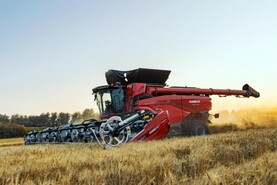All the cereal and rape fields have now been cleared of straw in a burst of activity after the earliest ever completion of the main part of the harvest.
I had four customers for the straw – all either local or I had dealt with them over the years.
Winter barley straw
In our part of the country, winter barley has become by far the straw of choice for the stud farms aiming to produce the future classic winners though I sold some of the oaten straw to an operation with similar ambitions. The wheaten straw will, I presume, mainly go to the mushrooms with some used as a source of fibre in the feeders.
I am loathe to break the rhythm of a system that has a degree of predictability about it
At the end of last week, we got our second cut of silage and also opened our first cut to supplement the meal diet that the finishing bulls are on. I have never had two pits of such dry silage. We haven’t had a drop of effluent even though we cleaned out the effluent collecting channels in the yard. The second cut was a bit better than I expected due to the land type it was on – a sticky glay which was once the base of a pre-historic lake.
The sward had deteriorated over the years so we burnt off the grass in advance of harvesting and will reseed the field. Hopefully, there is enough rain and moisture to encourage rapid germination and growth. The aim is to get it sown during the last week of August or the very early days in September.
Buying weanlings
With the second cut safely in the pit and our commercial cereals safely stored to be used as the main component of the fattening diet for the bulls, we have begun buying a few weanlings. I have been slightly taken aback at the reaction. Almost uniformly, it was that I must be mad.
I should, I was told, sell the grain, hay and straw and set the sheds with the silage to a dairy man with too many cows and too little feed.
Perhaps they are right though I am loathe to break the rhythm of a system that has a degree of predictability about it but I will revisit our budget and projections before committing ourselves too far.
Surprise
Meanwhile, I have, after the disappointment of the oats, been pleasantly surprised at the wheat.
None of the crops did less than 4t/acre, even a small field that had been in barley for the last number of years, though it got extra slurry last autumn as well as a take-all seed dressing.
But the crop results show the resilience of the mainstream cereals to variable weather conditions.
Read more
Home Farm: harvest almost complete
Grain trends: prices continue on an upward trend
All the cereal and rape fields have now been cleared of straw in a burst of activity after the earliest ever completion of the main part of the harvest.
I had four customers for the straw – all either local or I had dealt with them over the years.
Winter barley straw
In our part of the country, winter barley has become by far the straw of choice for the stud farms aiming to produce the future classic winners though I sold some of the oaten straw to an operation with similar ambitions. The wheaten straw will, I presume, mainly go to the mushrooms with some used as a source of fibre in the feeders.
I am loathe to break the rhythm of a system that has a degree of predictability about it
At the end of last week, we got our second cut of silage and also opened our first cut to supplement the meal diet that the finishing bulls are on. I have never had two pits of such dry silage. We haven’t had a drop of effluent even though we cleaned out the effluent collecting channels in the yard. The second cut was a bit better than I expected due to the land type it was on – a sticky glay which was once the base of a pre-historic lake.
The sward had deteriorated over the years so we burnt off the grass in advance of harvesting and will reseed the field. Hopefully, there is enough rain and moisture to encourage rapid germination and growth. The aim is to get it sown during the last week of August or the very early days in September.
Buying weanlings
With the second cut safely in the pit and our commercial cereals safely stored to be used as the main component of the fattening diet for the bulls, we have begun buying a few weanlings. I have been slightly taken aback at the reaction. Almost uniformly, it was that I must be mad.
I should, I was told, sell the grain, hay and straw and set the sheds with the silage to a dairy man with too many cows and too little feed.
Perhaps they are right though I am loathe to break the rhythm of a system that has a degree of predictability about it but I will revisit our budget and projections before committing ourselves too far.
Surprise
Meanwhile, I have, after the disappointment of the oats, been pleasantly surprised at the wheat.
None of the crops did less than 4t/acre, even a small field that had been in barley for the last number of years, though it got extra slurry last autumn as well as a take-all seed dressing.
But the crop results show the resilience of the mainstream cereals to variable weather conditions.
Read more
Home Farm: harvest almost complete
Grain trends: prices continue on an upward trend






 This is a subscriber-only article
This is a subscriber-only article









SHARING OPTIONS: